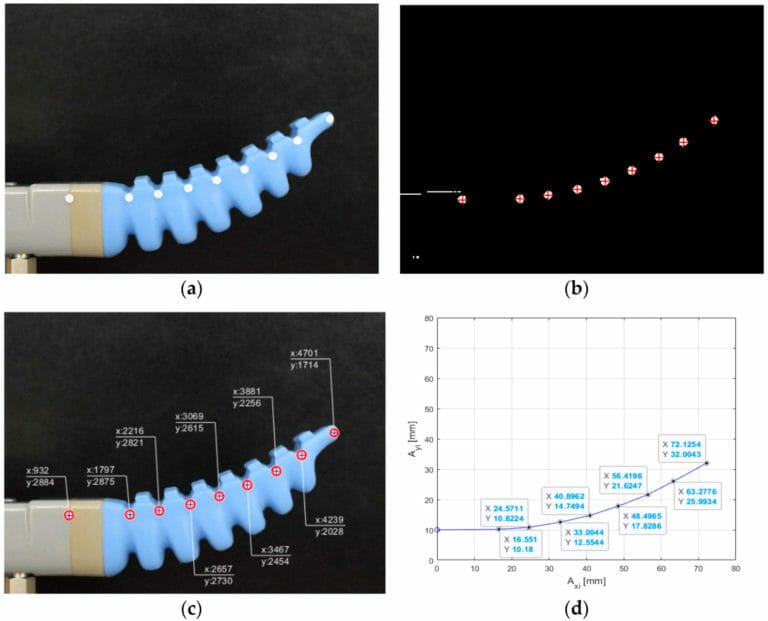Review: “Data-Driven Kinematic Model of PneuNets Bending Actuators for Soft Grasping Tasks”
Table of Contents
Soft robotics is an trending field of robotics that deals with designing robots using compliant materials that mimic the behavior of biological organisms. Pneumatic artificial muscles are a type of soft actuators that have gained significant attention due to their simple structure, low cost, and high power-to-weight ratio. In this article, we review a paper titled “Data-Driven Kinematic Model of PneuNets Bending Actuators for Soft Grasping Tasks” by Ciprian Lapusan, Olimpiu Hancu, and Ciprian Rad, where the authors propose a data-driven kinematic model to estimate the shape and opening level of a PneuNets soft gripper in relation to the applied pressure signal.
Introduction
The article starts by introducing the concept of soft robotics and the potential applications of PneuNets bending actuators in soft grasping tasks. The authors highlight the challenges associated with controlling the shape and position of these soft actuators due to their nonlinear behavior and lack of accurate models. One challenge with using PneuNets bending actuators is accurately modeling their behavior. In order to control the motion of a PneuNets bending actuator, it is necessary to have an accurate understanding of how the actuator will behave when subjected to different levels of pressure. This is particularly important when using PneuNets bending actuators in soft grasping tasks, where the shape of the actuator will directly impact the ability of the gripper to grasp an object.
To address this challenge, a group of researchers have proposed a data-driven kinematic model of PneuNets bending actuators for soft grasping tasks. This model uses a set of approximation functions derived from experimental data and an equivalent serial mechanism to estimate the free bending behavior of a PneuNets actuator based on the applied pressure signal.
The proposed model offers several advantages over previous methods for modeling PneuNets bending actuators. For one, it provides a real-time estimation of the shape and opening level of a PneuNets soft gripper. This makes it suitable for implementing in real-time applications involving soft grasping planning and size recognition of fragile objects with different sizes and shapes.
Additionally, the proposed model has applicability in sensorless/self-sensing bending control algorithms of PneuNets actuators. This is important because it allows for more precise and accurate control of the motion of the actuator, which in turn enables more precise and accurate control of the gripper.
The researchers tested their model on a commercial PneuNets actuator with decreasing chamber height, produced by us, SoftGripping. The model was validated through a set of experiments, where the shape and elementary displacements were measured using a digital image processing technique. The experimental data and the estimated data from the DAK model were compared and analyzed, respectively.
Overall, the proposed data-driven kinematic model of PneuNets bending actuators for soft grasping tasks offers a significant advancement in the field of soft robotics. By providing a real-time estimation of the shape and opening level of a PneuNets soft gripper, this model has the potential to enable more precise and accurate control of soft grippers in a variety of applications.

The authors briefly discuss the existing methods for modeling the behavior of Pneumatic artificial muscles, including analytical models, numerical models, and empirical models. They highlight the limitations of these approaches and the need for more accurate and reliable models.
The authors propose a novel data-driven approximation kinematic (DAK) model to estimate the shape and opening level of a PneuNets soft gripper in relation to the applied pressure signal. The DAK model estimates the free bending behavior of a PneuNets actuator (soft gripper finger) based on a set of approximation functions derived from experimental data and an equivalent serial mechanism that mimics the shape of the actuator. The model was tested for a commercial PneuNets actuator with decreasing chamber height, produced by our company, SoftGripping.

Experimental Validation
The authors conducted experiments to validate the proposed DAK model. The shape and elementary displacements were measured using a digital image processing technique. The experimental data and the estimated data from the DAK model were compared and analyzed, respectively. The results showed that the proposed DAK model has high accuracy and can estimate the shape and opening level of the PneuNets soft gripper in real-time applications involving soft grasping planning and size recognition of fragile objects with different sizes and shapes.
The authors compared their proposed DAK model with the existing methods for modeling the behavior of Pneumatic artificial muscles, including analytical models, numerical models, and empirical models. The results showed that the DAK model outperforms the other methods in terms of accuracy, computational time, and feasibility for real-time applications.
In conclusion, the authors propose a novel data-driven kinematic model for estimating the shape and opening level of a PneuNets soft gripper in relation to the applied pressure signal. The proposed DAK model has high accuracy, low computational time, and is suitable for real-time applications involving soft grasping planning and size recognition of fragile objects with different sizes and shapes. The experimental results validate the effectiveness of the proposed model, and it outperforms the existing methods for modeling the behavior of Pneumatic artificial muscles.
By the way, this paper uses a SoftGripping Actuator from our shop:
FAQs
1. What is soft robotics?
Soft robotics is an emerging field that deals with designing robots using compliant materials that mimic the behavior of biological organisms.
2. What are PneuNets bending actuators?
PneuNets bending actuators are a type of soft actuators that have gained significant attention due to their simple structure, low cost, and high power-to weight ratio. They are composed of a soft elastomer tube that is inflated with compressed air, causing the tube to bend and generate motion. PneuNets bending actuators have the potential to be used in a variety of applications, including soft robotics, wearable devices, and biomedical engineering.
Contact
We are happy to get in touch with you! Let’s have a quick talk and find out how to automate your application. Our engineers will validate your application and provide you with test material in form of videos pictures and whitepapers:


